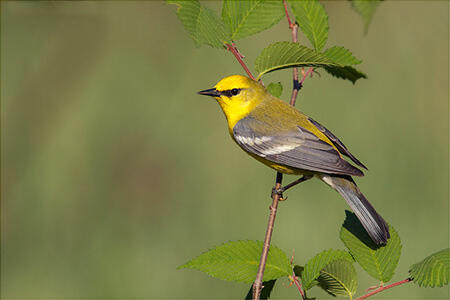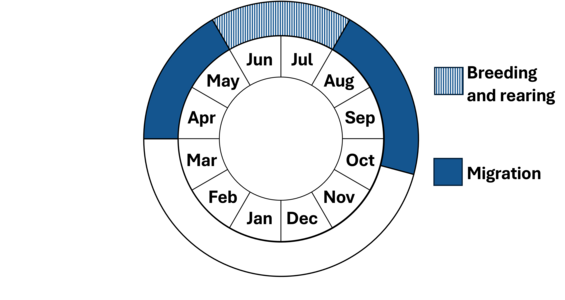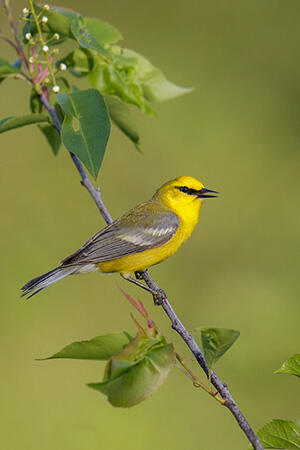- Scientific name: Vermivora cyanoptera
Species of Greatest Conservation Need (MA State Wildlife Action Plan)
Description

Blue-winged warbler (Vermivora cyanoptera)
The blue-winged warbler is an arthropod-gleaning passerine associated with areas of early-to-mid-successional habitat. It breeds in the eastern United States, primarily from southeast Michigan across to southern New England, and south through the Ohio Valley. Winter range is from Atlantic Mexico into Panama.
Life cycle and behavior
The blue-winged warbler is a single-brood species, building its nest on or near the ground in forest-field ecotones. This species is genetically very similar to the golden-winged warbler, and interbreeding is regularly documented.

Population status
Bird survey data shows that the population of blue-winged warbler has experienced an overall decline of 0.41 percent annually from 1966 to 2002. The greatest declines have occurred in Alabama (7.90%), Kentucky (7.34%), New Jersey (4.85%) and Connecticut (3.2%). In that time only one area, Pennsylvania, has experienced a significant population increase (3.11%). Massachusetts populations have declined by 1.06 percent annually.
The blue-winged warbler is considered a Tier I Conservation Priority by Partners in Flight and is listed as a watch list species by the National Audubon Society.
Distribution and abundance
The Massachusetts population of blue-winged warbler is loosely distributed across the state, with major concentrations occurring in the Connecticut River Valley, northeastern Essex County, and in the second- growth lowlands between Boston and Providence. They are scarce breeders on Cape Cod and the Islands and have not been recorded at elevations above 1,700 feet in Berkshire County.
Habitat

Blue-winged warbler (Vermivora cyanoptera)
The blue-winged warbler nests in early to mid-successional habitat, typically choosing a nest site in habitats that include saplings at the forest edge of clearings comprised of dense shrubby thickets. The species is not sensitive to patch size and often is found breeding in dense shrub vegetation associated with clearcuts and powerline right-of-ways. Patches with somewhat even structural diversity are favored, especially those composed of a mosaic of shrub, herb and woody vegetation (<15'). Suitable habitat can occur at the edges of wetlands and damp areas, or dry upland areas, independent of the presence or absence of water. Defended territories of unmated males are usually in wetter habitat. In Massachusetts, the blue-winged warbler breeds in brushy, overgrown pastures and at the edges of dense secondary growth.
Healthy habitats are vital for supporting native wildlife and plants. Explore habitats and learn about conservation and restoration in Massachusetts.
Threats
The major threat to blue-winged warbler populations in Massachusetts is loss of suitable habitat due to landscape conversion and succession. This species is also a frequent host of the brown-headed cowbird. Though shrubland birds as a group do not appear to be as sensitive to patch-size as other groups of birds, the indirect effects of suburban sprawl can be important through the magnified risks on ground nests from predation (i.e., domestic cats, raccoons) and cowbird parasitism.
Predation by domestic cats has been identified as the largest source of mortality for wild birds in the United States with the number of estimated mortalities exceeding 2 billion annually. Cats are especially a threat to those species that nest on or near the ground.
An additional threat to the species is collisions with buildings and other structures, as approximately 1 billion birds in the United States are estimated to die annually from building collisions. A high percentage of these collisions occur during the migratory periods when birds fly long distances between their wintering and breeding grounds. Light pollution exacerbates this threat for nocturnal migrants as it can disrupt their navigational capabilities and lure them into urban areas, increasing the risk of collisions or exhaustion from circling lit structures or areas.
Conservation
Management for the blue-winged warbler should seek to maintain habitat diversity in the region, specifically to increase the array of woody plant communities in early to midseral stages of secondary succession. A variety of management tools, including mechanical removal of vegetation to mimic disturbance, and prescribed burns in fire-dependent habitats, should be employed to achieve suitable habitat. In landscapes that are primarily forested, early successional forest patches should be included in rotational forest management where several small and several large early successional patches are rotated through the forest matrix. Managing utility rights-of-way has enormous potential for increasing habitat availability for shrubland birds. Capitalizing on these already existing and essentially permanent shrublands should be encouraged whenever possible. Where suitable habitat currently exists, efforts should be made to protect the landscape from development.
Promote responsible pet ownership that supports wildlife and pet health by keeping cats indoors and encouraging others to follow guidelines found at fishwildlife.org.
Bird collision mortalities can be minimized by making glass more visible to birds. This includes using bird-safe glass in new construction and retrofitting existing glass (e.g., screens, window decals) to make it bird-friendly and reducing artificial lighting around buildings (e.g., Lights Out Programs, utilizing down shielding lights) that attract birds during their nocturnal migration.
References
Askins, R.R. Restoring North American Birds. New Haven, CT: Yale University, 2000.
Gill, F.B., R.A. Canterbury, and J.L. Confer. “Blue-winged Warbler (Vermivora pinus).” 2001. The Birds of North America, No. 584 (A. Poole and F. Gill, eds.). Philadelphia, PA: The Birds of North America, Inc.
Sauer, J.R., J.E. Hines, and J. Fallon. The North American Breeding Bird Survey, Results and Analysis 1966-2003. Version 2004.1. Laurel, MD: USGS Patuxent Wildlife Research Center, 2004.
Veit, R., and W.R. Petersen. Birds of Massachusetts. Lincoln, MA: Massachusetts Audubon Society, 1993.
Contact
| Date published: | April 4, 2025 |
|---|